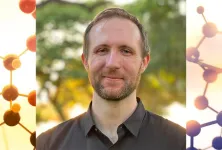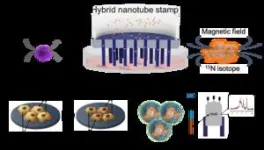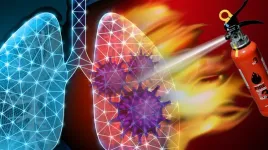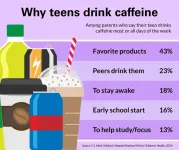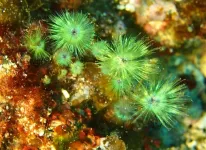(Press-News.org) HOUSTON – (May 20, 2024) – Rice University chemist Julian West is one of a dozen up-and-coming young scientists featured in Chemical & Engineering News’ (C&EN) 2024 Talented 12, an annual issue of the weekly news magazine that highlights rising stars across all chemistry research disciplines.
West, an assistant professor and the Norman Hackerman-Welch Young Investigator in Rice’s Department of Chemistry, is a synthetic chemist whose lab designs novel chemical reactions. Drawing inspiration from biology, West’s research group has found ways to simplify the production of entire libraries of feedstock chemicals for drug and chemical manufacturers. Not only are West’s methods more sustainable than the mainstay reactions chemical makers have relied on for decades, they use catalysts that are far cheaper than the gold, palladium, rhodium and other rare-metal industry standards.
West is the third chemist named to C&EN’s Talented 12 from Rice’s Wiess School of Natural Sciences in four years. Associate Professor Hans Renata, whose lab works at the interface of organic synthesis, enzymology and natural product chemical biology, made the 2021 list. Assistant Professor Raúl Hernández Sánchez, whose lab combines supramolecular, organic, inorganic and materials chemistry, was featured in 2023. C&EN is the American Chemical Society’s flagship news magazine.
The West lab’s notable achievements include a reliable and cost-effective “catch-and-attach” process for adding fluorine to molecules in drug production. Fluorine can increase a drug’s absorption and prolong its lifetime, but adding it has typically required chemicals that are expensive and highly reactive. West’s team found a way to attach fluorine atoms to alkene feedstocks via an alkylation reaction that is catalyzed by iron and sulfur.
“Nature makes all of these really amazing, complicated molecules, and it does it using the most common elements like iron, cobalt and sulfur, basically the elements in dirt,” West said. “The question that motivates our group is, ‘Can we bring lessons from nature into methods that chemists use to make molecules?’”
West said the 2023 paper was particularly gratifying for several reasons. First, it built on a number of breakthroughs led by different students and postdoctoral researchers in the group over the previous five years. Second, it brought them together in a reaction that was simple, cheap and extraordinarily useful.
“What got us really excited about that reaction was that it allowed us to mix and match all these different kinds of alkenes and fluorine-containing fragments,” he said. “Using really simple iron and sulfur catalysts and a little bit of light, we found we could make a huge library of molecules. Basically, we didn’t really find a case where the reaction didn’t seem to work.”
Another breakthrough from West’s group was a process to produce alkene precursors, also known as olefins, via a light-driven process using vitamin B12. The 2021 study in Chemical Science was inspired by the 2015 discovery of a vitamin B12-containing enzyme that some bacteria use to detect light. The olefin-producing process developed by West and postdoctoral researcher Radha Bam eliminated the need for harsh chemicals, like caustic bases, that have been used in olefin production for more than a century.
As opposed to the ionic reactions that have dominated industrial chemistry since its inception, West’s group and others seek to use reactions that have unpaired electrons, which are also known as radicals. Radicals are shunned in traditional ionic chemistry, which has dominated the chemical industry since its inception.
“Our understanding of radical interactions and more broadly of the organometallic chemistry that drives them has really only started to get more sophisticated in the last 40 years,” West said. “And really, there’s been a huge acceleration in the last 10 or 20. As we’re learning more and more about them, what we’re finding is they can also be very clean and very selective and not make all of the byproducts that are produced by ionic processes.”
- by Jade Boyd, Associate Director of Communications, Wiess School of Natural Sciences
-30-
This news release can be found online at news.rice.edu.
Follow Rice News and Media Relations via Twitter @RiceUNews.
Image downloads:
https://news-network.rice.edu/news/files/2024/05/West.jpg
CAPTION: Julian West, an assistant professor and the Norman Hackerman-Welch Young Investigator in Rice’s Department of Chemistry, is one of a dozen up-and-coming young scientists featured in Chemical & Engineering News’ (C&EN) 2024 Talented 12.
(Photo courtesy of Julian West/Rice University)
Related stories:
Vitamin boosts essential synthetic chemistry – Dec. 8, 2020
https://news.rice.edu/news/2020/vitamin-boosts-essential-synthetic-chemistry
Lab lights way to simple chemical synthesis – Jan. 5, 2023
https://news.rice.edu/news/2023/lab-lights-way-simple-chemical-synthesis
Process to customize molecules does double duty – June 22, 2022
https://news.rice.edu/news/2022/process-customize-molecules-does-double-duty
Fluorince catch-and-attach process could boost drug efficiency – Nov. 13, 2023
https://news.rice.edu/news/2023/fluorine-catch-and-attach-process-could-boost-drug-efficiency
Links:
West lab: westchem.org
Department of Chemistry: chemistry.rice.edu
Wiess School of Natural Sciences: naturalsciences.rice.edu
C&EN Talented 12 2024: cen.acs.org/people/profiles/CENs-Talented-12/102/i15
About Rice:
Located on a 300-acre forested campus in Houston, Rice University is consistently ranked among the nation’s top 20 universities by U.S. News & World Report. Rice has highly respected schools of architecture, business, continuing studies, engineering, humanities, music, natural sciences and social sciences and is home to the Baker Institute for Public Policy. With 4,574 undergraduates and 3,982 graduate students, Rice’s undergraduate student-to-faculty ratio is just under 6-to-1. Its residential college system builds close-knit communities and lifelong friendships, just one reason why Rice is ranked No. 1 for lots of race/class interaction, No. 2 for best-run colleges and No. 12 for quality of life by the Princeton Review. Rice is also rated as a best value among private universities by Kiplinger’s Personal Finance.
END
Chemist Julian West makes C&EN magazine’s ‘Talented 12’ list
Rice researcher is among chemistry’s top young talents, according to magazine
2024-05-20
ELSE PRESS RELEASES FROM THIS DATE:
Robot-phobia could exasperate hotel, restaurant labor shortage
2024-05-20
VANCOUVER, Wash. – Using more robots to close labor gaps in the hospitality industry may backfire and cause more human workers to quit, according to a Washington State University study.
The study, involving more than 620 lodging and food service employees, found that “robot-phobia” – specifically the fear that robots and technology will take human jobs – increased workers’ job insecurity and stress, leading to greater intentions to leave their jobs. The impact was more pronounced with employees who had ...
Study offers new detail on how COVID-19 affects the lungs
2024-05-20
In some severe cases of COVID-19, the lungs undergo extreme damage, resulting in a range of life-threatening conditions like pneumonia, inflammation, and acute respiratory distress syndrome. The root cause of those wide-ranging reactions in the lungs has until now remained unclear.
A new study by researchers at Columbia and the Columbia University Irving Medical Center sheds light on this mystery. The study found that ferroptosis, a form of cell death first named and identified at Columbia in 2012, is the major cell death mechanism that underlies COVID-19 lung disease. The finding indicates that deliberately halting ...
Body’s ‘message in a bottle’ delivers targeted cancer treatment
2024-05-20
Researchers at Karolinska Institutet in Sweden have succeeded in delivering targeted cancer treatment via small membrane bubbles that our cells use to communicate. A new study published in Nature Biomedical Engineering shows that the treatment reduces tumour growth and improves survival in mice.
When our cells communicate, they send out small membrane bubbles known as extracellular vesicles which contain various signalling molecules. Interest in these tiny bubbles, sometimes referred to as the body’s ...
1 in 4 parents say their teen consumes caffeine daily or nearly every day
2024-05-20
ANN ARBOR, Mich. – A quarter of parents report that caffeine is basically part of their teen’s daily life, according to a national poll.
Two in three parents think they know whether their teen’s caffeine intake is appropriate and which products have too much caffeine. Yet a third aren’t able to identify recommended caffeine limits, according to the University of Michigan Health C.S. Mott Children’s Hospital National Poll on Children’s Health.
“Our report suggests parents may not always be aware of how much they should be limiting caffeine consumption for teens,” said poll co-director and Mott ...
What makes some brown algae shimmer and others not?
2024-05-20
Compartments of consistently sized, tightly packed microspheres are what makes some brown algae shimmer like opal. The Kobe University discovery not only sheds light on the mechanism behind the alga’s structural coloration, it is also the first to spot the effect in an order of brown algae other than the two where it was known to occur.
Most brown algae are indeed yellowish-brown, but scuba divers noticed that a species resembling Sporochnus in the order Sporochnales shimmers like peacock feathers in yellow, ...
Seeking stronger steel, systematic look at 120 combinations of alloy elements provides clues
2024-05-20
Decarbonization of automobiles not only requires a shift from gasoline engines to electric motors, but also quality steel parts that help the motors run while lessening the weight of vehicles. High-performance steel materials can offer quieter rides and resist the wear and tear from high-speed rotation in motors. To create them, the process of modifying the steel surface with carbon, nitrogen, and alloy elements needs to be optimized.
To understand the interactions between elements in steel, a systematic investigation ...
Tricking the Brain’s inner GPS: Grid cells responses to the illusion of self-location
2024-05-20
Dr. Hyuk-June Moon from the Bionics Research Center at the Korea Institute of Science and Technology (KIST), in collaboration with Prof. Olaf Blanke’s team at the Swiss Federal Institute of Technology Lausanne (EPFL), has successfully induced self-location illusions with multi-sensory virtual reality (VR) in the MRI scanner and observed corresponding changes in the human brain's grid cell activity.
The brain is known to contain grid cells and place cells, which perform global positioning system (GPS) functions that allow us to recognize where we are. While ...
Gallbladder cancer rises among Black Americans as cases decline in other groups
2024-05-20
WASHINGTON, DC (May 20, 2024) — Gallbladder cancer rates have been stable or declining for most Americans over the last two decades, but cases have steadily risen among Blacks, with growing numbers not being diagnosed until later stages, according to a study scheduled for presentation at Digestive Disease Week® (DDW) 2024.
“Gallbladder cancer diagnosis at late stage can be highly detrimental,” said lead author Yazan Abboud, MD, internal medicine resident at Rutgers University New Jersey Medical School. “This could be due to a lack of timely ...
Biomarker for gastric cancer and other cancer studies set for digestive disease week
2024-05-20
Washington (May 14, 2024) — Cancer-related studies, including a diagnostic tool for gastric cancer and trends in gallbladder and colorectal cancers, will be presented this week at Digestive Disease Week (DDW) 2024. Abstracts are available to registered media, and press releases are available where noted. Studies are embargoed until 12:01 a.m. EDT the day of presentation, unless otherwise noted.
Here are summaries of the new research on the schedule:
Oral microbiome signatures as potential biomarkers for gastric cancer risk assessment, Abstract 949, will be presented Monday, May 20, at 4:15 p.m. EDT. (A press release is available upon request. Embargoed until 12:01 a.m. EDT ...
Endoscopic studies presented at Digestive Disease Week
2024-05-20
Washington (May 14, 2024) — Studies featuring endoscopic and laparoscopic procedures, including patient views on artificial intelligence in endoscopy and hazards to healthcare personnel of smoke-producing procedures, will be presented this week at Digestive Disease Week (DDW) 2024. Abstracts are available to registered media, and press releases are available where noted. Research is embargoed until 12:01 a.m. EDT the day of presentation, unless otherwise noted.
Here are summaries of the new research:
Patients’ sentiments ...
LAST 30 PRESS RELEASES:
This self-powered eye tracker harnesses energy from blinking and is as comfortable as everyday glasses
Adverse prenatal exposures linked to higher rates of mental health issues, brain changes in adolescents
Restoring mitochondria shows promise for treating chronic nerve pain
Nature study identifies a molecular switch that controls transitions between single-celled and multicellular forms
USU chemists' CRISPR discovery could lead to single diagnostic test for COVID, flu, RSV
Early hominins from Morocco reveal an African lineage near the root of Homo sapiens
Small chimps, big risks: What chimps show us about our own behavior
We finally know how the most common types of planets are created
Thirty-year risk of cardiovascular disease among healthy women according to clinical thresholds of lipoprotein(a)
Yoga for opioid withdrawal and autonomic regulation
Gene therapy ‘switch’ may offer non-addictive pain relief
Study shows your genes determine how fast your DNA mutates with age
Common brain parasite can infect your immune cells. Here's why that's probably OK
International experts connect infections and aging through cellular senescence
An AI–DFT integrated framework accelerates materials discovery and design
Twist to reshape, shift to transform: Bilayer structure enables multifunctional imaging
CUNY Graduate Center and its academic partners awarded more than $1M by Google.org to advance statewide AI education through the Empire AI consortium
Mount Sinai Health system receives $8.5 million NIH grant renewal to advance research on long-term outcomes in children with congenital heart disease
Researchers develop treatment for advanced prostate cancer that could eliminate severe side effects
Keck Medicine of USC names Christian Pass chief financial officer
Inflatable fabric robotic arm picks apples
MD Anderson and SOPHiA GENETICS announce strategic collaboration to accelerate AI-driven precision oncology
Oil residues can travel over 5,000 miles on ocean debris, study finds
Korea University researchers discover that cholesterol-lowering drug can overcome chemotherapy resistance in triple-negative breast cancer
Ushikuvirus: A newly discovered giant virus may offer clues to the origin of life
Boosting the cell’s own cleanup
Movement matters: Light activity led to better survival in diabetes, heart, kidney disease
Method developed to identify best treatment combinations for glioblastoma based on unique cellular targets
Self-guided behavioral app helps children with epilepsy sleep earlier
Higher consumption of food preservatives is associated with an increased risk of type 2 diabetes
[Press-News.org] Chemist Julian West makes C&EN magazine’s ‘Talented 12’ listRice researcher is among chemistry’s top young talents, according to magazine
